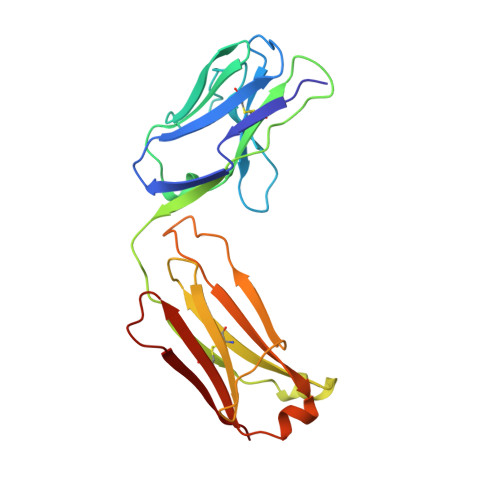The structure of an entire noncovalent immunoglobulin kappa light-chain dimer (Bence-Jones protein) reveals a weak and unusual constant domains association.
Roussel, A., Spinelli, S., Deret, S., Navaza, J., Aucouturier, P., Cambillau, C.(1999) Eur J Biochem 260: 192-199
- PubMed: 10091599
- DOI: https://doi.org/10.1046/j.1432-1327.1999.00136.x
- Primary Citation of Related Structures:
1B6D - PubMed Abstract:
Monoclonal free light chains secreted in immunoproliferative disorders are frequently involved in renal complications, including a specific proximal tubule impairment, Fanconi's syndrome. The latter is characterized in most cases by intracellular crystallization including a light-chain variable-domain fragment which resists lysosomal proteases. Bence-Jones protein (BJP) DEL was isolated from a patient with myeloma-associated Fanconi's syndrome. The crystal structure of this human kappa immunoglobulin light-chain noncovalent dimer was determined using molecular replacement with the structure of molecule REI, as the variable domain, and that of BJP LOC as the constant domain. To our knowledge, DEL is the first complete kappa BJP structure described to date. The R-factor is 20.7% at 2.8 A resolution. The BJP DEL dimer was compared with other light-chain dimers and with Fab fragments with a kappa light chain. Although the domain-folding pattern was similar, the relative positions of the constant domains differed. BJP DEL showed a noncanonical quaternary structural arrangement which may be attributable to the poor CL-CL affinity and lack of an interchain disulfide bridge, combined with the conformational editing effect of the crystal-packing forces. Our results suggest that, in the absence of a disulfide bridge, most BJP CLs are probably mobile in solution. This may explain their high susceptibility to proteases and the absence of naturally occurring crystals for these dimers. Furthermore, these findings of an unusual quaternary structure of an immunoglobulin light-chain association extend our knowledge about the large and highly diverse structures of the immunoglobulin superfamily.
Organizational Affiliation:
UPR 9039-CNRS, Marseille, France.














